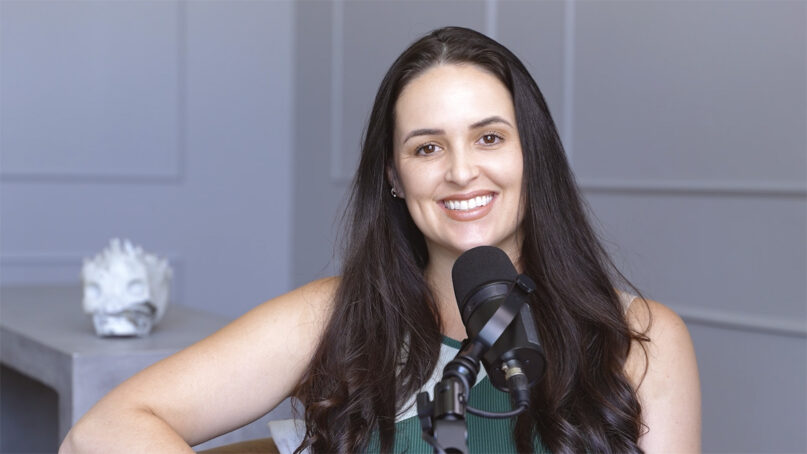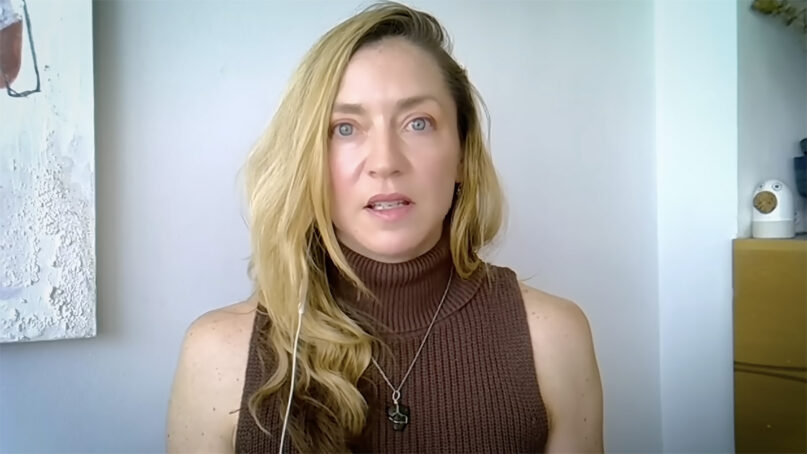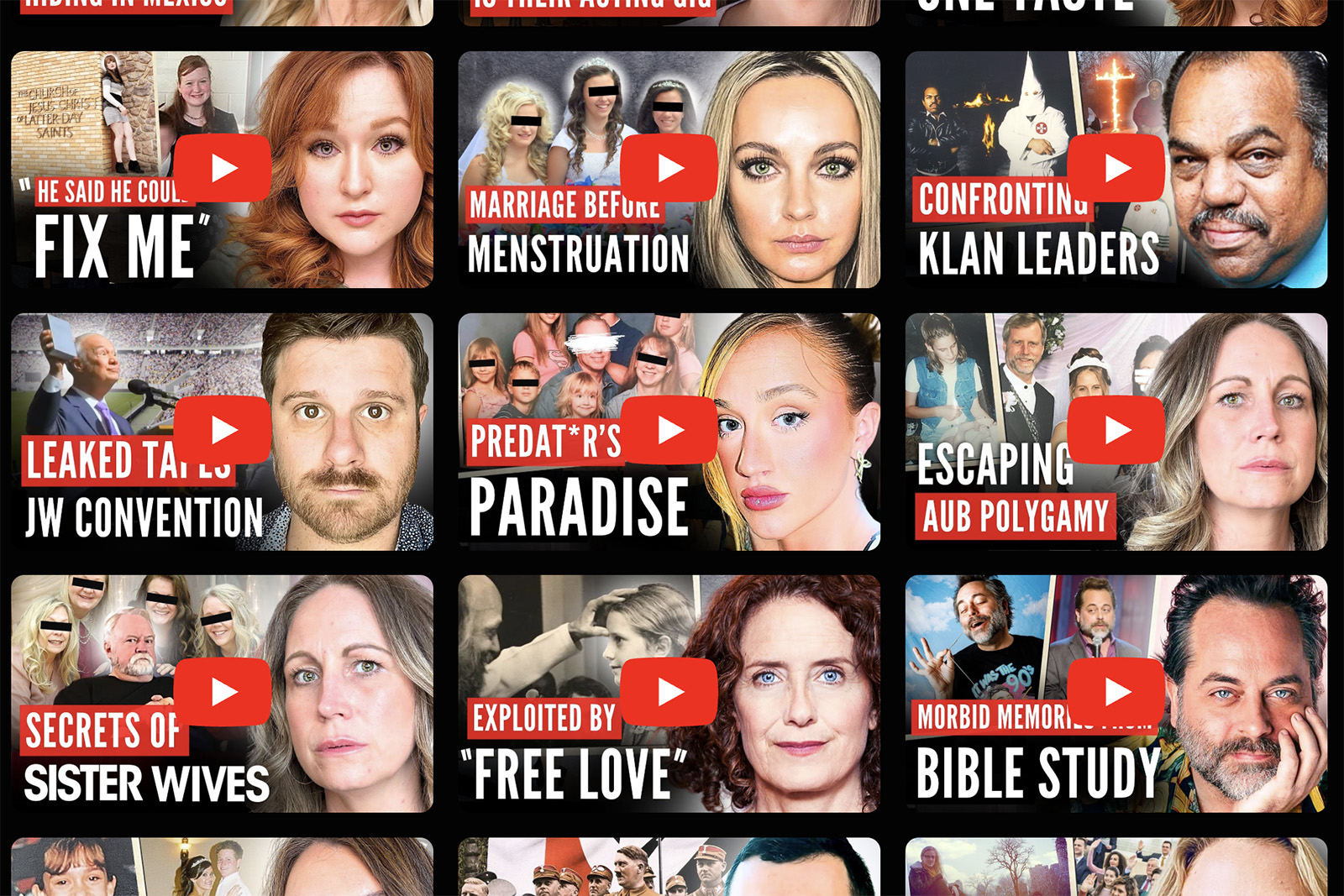(RNS) — Shelise Ann Sola grew up in a devout Mormon family in Tremonton, Utah. At 19, after being berated by her local bishop for being sexually active with her boyfriend, she began to question her faith, she told RNS.
Then, when she was 27, after leaving the church and moving to Las Vegas, memories of suffering sexual abuse as a child at the hands of her father resurfaced.
“I would wake up screaming and hyperventilating until I figured out what it was,” Sola said.
Sola confronted her father soon after the memories began. He eventually admitted to the abuse when she was 32 — two weeks before her wedding, she said.
“It took five years for him to admit to everything,” Sola, now 34, said. “But those are experiences that I can hold compassion for and have a better understanding of how to talk to survivors because of them.”
Today, Sola is the host of Cults to Consciousness, a YouTube channel with 326,000 subscribers she runs with her husband and co-producer, Jonathan Rosales. Since the channel’s launch in 2022, Sola has interviewed hundreds of survivors who escaped what she often described as “high-control” religious and/or spiritual groups, or more plainly, cults. Guests recount harrowing journeys through systems of manipulation, abuse and control by fear and exclusion in long-form interviews.

Shelise Ann Sola. (Photo courtesy of Sola)
Most of the guests are women, and so is more than 80% of the channel’s audience, Rosales said. In three years, the videos have racked up millions of views.
“We are not anti-religion,” said Sola, who now lives in Austin, Texas, with Rosales and their 16-month-old daughter. “We’re just anti-abuse, manipulation and control.”
A 2023 study from the Global Center for Religious Research on religious trauma found about a third of Americans have experienced religious trauma in their lifetimes, defining the experience as trauma “resulting from an event, series of events, relationships or circumstances within or connected to religious beliefs, practices or structures that is experienced by an individual as overwhelming or disruptive and has lasting adverse effects on a person’s physical, mental, social, emotional, or spiritual well-being.”
However, most therapists in the country lack religion and spirituality training, research suggests. Monica Amorosi, a licensed trauma counselor in New York, said few therapists specialize in religious trauma because the path to specialization is too narrow.
“It just doesn’t come up in graduate school,” Amorosi said. “To be quite frank, we’ve only just started educating on trauma in general.”
Serena Kelly made a guest appearance on the channel in December 2024. Kelly was born into the cult known as Children of God and endured regular mental, physical and sexual abuse, she said. Now a licensed trauma recovery specialist, she said the experience of telling her story on the channel was a meaningful form of advocacy.

Serena Kelly appears as a guest on a “Cults to Consciousness” episode. (Video screen grab)
“I’ve been on other true crime podcasts,” Kelly said. “I want to make people aware that this can happen to anyone.”
True crime is an increasingly popular genre of entertainment that explores real-life crimes, often involving violence. However, Kelly said shows like “Cults to Consciousness” help to dismantle stereotypes about what abuse looks like and who it affects.
RELATED: ‘Holy Hurt’ is Hillary McBride’s field guide to the shattering impact of spiritual trauma
“I don’t look like somebody who has been trafficked and gone through crazy trauma and been a child bride and begged on the street,” Kelly said. “I think way more people are becoming aware of their surroundings.”
Amorosi said she sees platforms like “Cults to Consciousness” emerging as digital spaces for validation and awareness, both for a predominantly female audience and for the survivors who share their stories.
“It can be a form of therapeutic media, even if it is not, in and of itself, therapy,” Amorosi said. “A lot of women are able to go, ‘I know that feeling.’ It can be very connecting.”
Rosales, 41, who describes himself as a “student of YouTube” because of his background in media production, said the channel’s audience generally falls into three categories: true crime enthusiasts, fans of long-form storytelling and survivors of abuse.
Although extreme or bizarre cults may seem to be the most attention-grabbing for YouTube audiences, Rosales said most viewers are more drawn to familiar groups, like the Amish or Islam. The channel is careful not to focus too heavily on any one faith, he added.
“You can’t leave people alienated on the sidelines,” Rosales said. “There’s like this chess game of when to bring back a certain thing and when to introduce something new.”
The couple originally envisioned the channel as a space to explore spirituality beyond organized religion, with a focus on psychology and consciousness-expanding practices like plant medicine or ketamine therapy used by those who have experienced religious trauma. But, the show ultimately shifted toward long-form storytelling after Sola and Rosales noticed it resonated with viewers.

Promotional artwork with Shelise Ann Sola and husband Jonathan Rosales, co-hosts of “Cults to Consciousness.” (Image courtesy of Sola)
Sola said as the channel began to take shape, it was difficult to navigate her new role interviewing people with religious trauma. She continues to rely on Rosales’ support, she said.
“It definitely takes a toll,” she said. “I mean, yesterday I had an interview that directly mirrored my trauma, and after the two-and-a-half-hour interview, I just sobbed in Jonathan’s arms.”
RELATED: To feel safe in the pews, trauma must be acknowledged, spiritual directors say
Sola has yet to find a therapist she connects with, she said, but in the meantime she relies on body-based therapeutic practices like massage, which she said helps release the trauma she absorbs from interviews. She also said she often walks away from interviews with new insights, learning from guests’ healing journeys.
“A lot of times during interviews, if it seems like I’m relating a lot of my experience, it’s because I personally feel like that guest needs to hear some reinforcement of, ‘I understand,’” said Sola, who doesn’t often speak about her personal trauma on the show. “It’s a fine line of compassion — really holding it together for them and for the channel.”
Sola said ultimately for her, the emotional toll is outweighed by the channel’s impact.
“We get messages every day — comments, DMs, saying, ‘Thank you for your channel. It’s helped me understand my own life or how to talk to my partner,'” she said.
Amorosi said that for some, sharing their story of trauma publicly can be cathartic, but she warns that without the right coping mechanisms, it can be dangerous.
“You really want to make sure that you can survive your own remembering,” she said. “Because once you give that story to the internet, it doesn’t belong to you anymore.”
Beatrice Weber, a survivor who described abuse in a Hasidic community in the Williamsburg neighborhood of Brooklyn, New York, and appeared on the show in January 2024, said she experienced a “vulnerability hangover” the day after the video aired.
“The next day, I like panicked,” Weber said. “I just felt so vulnerable.” She quickly reached out to Sola, who she said was supportive, and Weber’s panic shifted to gratitude.
“I think so many people cannot speak about these issues, and I am able to,” Weber said. “I know that people in the community listen to my interviews. Sometimes they reach out to me. It makes a difference to them.”
Jasmin Faulk-Dickerson, an author and educator whose video about her escape from Saudi Arabia as an ex-Muslim is the second-most viewed on the channel, said being featured on it was unlike any other experience.
“The video puts a face and a voice to it,” Faulk-Dickerson told RNS, adding that she received negative reactions from family living in Saudi Arabia who had seen the video on YouTube.
Faulk-Dickerson emphasized that her aim was not to stir controversy by telling her story on the platform, but to encourage honest and thoughtful dialogue.
“The global community has completely turned a blind eye to what women deal with in certain parts of the world,” she said. “What we don’t address is repeated and perpetuated time and time again. So, that’s the urgency. This has nothing to do with me.”
Both Weber and Faulk-Dickerson have appeared in two more videos on “Cults to Consciousness” since their initial interviews.
“When you have experienced a certain life, you find yourself, unfortunately, not by choice, equipped to address specific situations,” Faulk-Dickerson said. “I never thought I’d want that kind of attention, but I realize that I have a responsibility.”
Sola is now working on a book about her experience, and she and Rosales are producing a documentary about a cult they are investigating. She said they also intend to grow the “Cults to Consciousness” brand through speaking engagements and conference appearances, “to be viewed as more of an authority in the space, not just YouTubers.”
“Cult survivors are often exploited and sensationalized — they’re always left out of the equation,” she said. “We want to give them a voice and bring awareness.”




